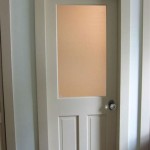Understanding R-Value for Interior Wall Insulation
Insulating interior walls is a practice that extends beyond merely managing temperature. While thermal regulation is a significant advantage, interior wall insulation also contributes to sound dampening, creating more private and comfortable living spaces. The term "R-value" is a crucial element in understanding insulation performance. It represents a material's resistance to heat flow; the higher the R-value, the greater the insulation's effectiveness.
Choosing the appropriate R-value for interior walls involves several factors, including the specific goals of the insulation project, the existing structure of the building, and local climate considerations. Unlike exterior walls, which directly face temperature fluctuations and weather conditions, interior walls primarily address sound transmission and maintaining consistent temperatures between rooms. Therefore, the R-value selection process differs from that of exterior wall insulation.
There is no universally mandated R-value for interior walls. Building codes typically focus on exterior walls and energy efficiency within the building envelope. The decision on whether to insulate interior walls and what R-value to use rests primarily on the homeowner's or building owner's objectives. These objectives may include reducing noise between rooms, improving temperature consistency, or enhancing the overall comfort and tranquility of the living space.
Consequently, determining the optimal R-value for interior walls requires a holistic assessment of the building's needs and the specific challenges it presents. Understanding the factors influencing R-value selection allows for a more informed decision-making process, leading to improved comfort and utility within the building.
Factors Influencing R-Value Choice for Interior Walls
Several key factors influence the selection of an appropriate R-value for interior walls. These factors encompass the intended purpose of the insulation, the building's construction, and the specific areas to be insulated. By carefully considering these elements, one can arrive at an R-value that effectively addresses the desired outcomes.
1. Sound Attenuation Requirements:
The primary driver for many interior wall insulation projects is sound reduction. Noise transmission between rooms can be a significant source of disturbance, especially in multi-family dwellings or homes with shared living spaces and bedrooms. The desired level of soundproofing directly influences the R-value selection. Materials with higher R-values, particularly those with dense compositions, tend to offer superior sound dampening qualities due to their increased mass and ability to absorb sound waves.For example, in a home theater or recording studio, minimizing sound leakage is paramount. In such cases, higher R-value insulation, coupled with other soundproofing measures, is essential. Conversely, if the primary concern is simply reducing conversations between a living room and a bedroom, a lower R-value may suffice.
The composition and density of the insulation material itself also play a role in sound absorption. Mineral wool and fiberglass insulation, known for their fibrous structure, can effectively trap sound waves and reduce their transmission. Closed-cell spray foam insulation, while offering high R-values, may not be as effective at sound dampening compared to fibrous materials due to its rigid structure.
2. Temperature Consistency Goals:
While not as crucial as with exterior walls, interior wall insulation can contribute to maintaining more consistent temperatures between adjacent rooms. This is particularly relevant in situations where rooms are heated or cooled independently, or where one room tends to naturally run warmer or cooler than others.For instance, a sunroom that receives significant solar gain may become considerably warmer than an adjacent hallway. Insulating the wall between these two spaces can help to moderate temperature differences, preventing the sunroom from overheating the hallway. Similarly, in a home with a poorly insulated attic, rooms located directly beneath the attic may experience temperature fluctuations. Insulating the interior walls of these rooms can help to stabilize their temperature.
In these scenarios, the desired level of temperature consistency will influence the R-value selection. Higher R-values will provide greater thermal resistance, reducing heat transfer between rooms. However, it's important to note that interior wall insulation alone may not be sufficient to completely eliminate temperature differences, particularly in cases of significant temperature gradients or poor insulation in other areas of the building.
3. Wall Construction and Framing:
The existing construction of the wall, including the framing material and cavity depth, will significantly impact the choice of insulation and its achievable R-value. Standard wall framing with 2x4 studs creates a shallower cavity compared to 2x6 framing, limiting the thickness of insulation that can be installed. This, in turn, restricts the maximum achievable R-value.In walls with 2x4 framing, batt insulation with an R-value of R-13 or R-15 is commonly used. In walls with 2x6 framing, higher R-values, such as R-19 or R-21, are achievable. Spray foam insulation, which expands to fill the entire cavity, can also be used in both 2x4 and 2x6 walls, providing higher R-values per inch compared to batt insulation.
Furthermore, the presence of obstructions within the wall cavity, such as pipes or wiring, may affect the installation of certain types of insulation. Spray foam insulation can easily conform to these obstructions, while batt insulation may require careful cutting and fitting. Understanding the limitations imposed by the wall construction is essential for selecting an appropriate R-value and ensuring proper insulation installation.
Common R-Values and Insulation Types for Interior Walls
While there is no mandated R-value, certain R-values and insulation types are commonly employed for interior wall applications. The selection depends on the factors outlined in the previous section, including sound attenuation requirements, temperature consistency goals, and wall construction limitations.
1. R-13 to R-15 Fiberglass or Mineral Wool Batts:
These are among the most widely used options for interior walls, particularly in standard 2x4 stud walls. They offer a balance between cost-effectiveness, ease of installation, and moderate sound dampening capabilities. Fiberglass batts are readily available at most home improvement stores and are relatively simple to install. Mineral wool batts, while slightly more expensive, offer better sound absorption characteristics and are more resistant to fire.These R-values are typically sufficient for reducing normal speech and television noise between rooms. However, they may not be adequate for blocking loud noises or creating a truly soundproof environment. Installation involves fitting the batts snugly within the wall cavities, ensuring that they fill the space completely without being compressed. Gaps or voids in the insulation can significantly reduce its effectiveness.
2. R-19 to R-21 Fiberglass or Mineral Wool Batts:
These higher R-value batts are typically used in 2x6 stud walls to maximize insulation performance. They offer improved sound dampening and thermal resistance compared to R-13 or R-15 batts. While the installation process is similar, care must be taken to ensure that the thicker batts fit snugly within the wall cavities without being compressed. Compression can reduce the R-value of the insulation.These R-values are suitable for situations where greater sound attenuation or temperature consistency is desired. They can be effective in reducing noise from home theaters, music rooms, or adjacent bedrooms. They can also help to stabilize temperatures in rooms with significant temperature fluctuations.
3. Spray Foam Insulation (Varying R-Values):
Spray foam insulation offers a versatile solution for interior walls, providing high R-values and excellent air sealing properties. There are two main types of spray foam: open-cell and closed-cell. Closed-cell spray foam has a higher R-value per inch compared to open-cell foam, but it may not be as effective at sound dampening due to its rigid structure. Open-cell spray foam, while having a lower R-value per inch, offers better sound absorption characteristics.The R-value of spray foam insulation can be tailored to the specific needs of the project by adjusting the thickness of the application. Spray foam insulation also expands to fill all gaps and voids within the wall cavity, creating a tight seal that reduces air leakage and improves energy efficiency. However, spray foam insulation is typically more expensive than batt insulation and requires professional installation.
4. Other Insulation Options:
Other insulation options, such as cellulose insulation, can also be used in interior walls. Cellulose insulation is made from recycled paper and is often blown into wall cavities. It offers good sound dampening and thermal resistance at a relatively low cost. However, cellulose insulation may settle over time, potentially reducing its effectiveness. Rigid foam boards, such as polystyrene or polyisocyanurate, can also be used in interior walls, but they are typically more expensive and may require more specialized installation techniques. These options are less common for interior walls compared to fiberglass, mineral wool, and spray foam insulation.Additional Considerations for Interior Wall Insulation
Beyond selecting the appropriate R-value and insulation type, several additional considerations are important for ensuring a successful interior wall insulation project. These considerations include moisture control, fire safety, and proper installation techniques. Addressing these factors can help to maximize the benefits of insulation while minimizing potential risks.
1. Moisture Control:
While interior walls are not directly exposed to the elements, moisture can still accumulate within wall cavities due to condensation or leaks. Moisture can degrade insulation performance, promote mold growth, and damage building materials. Therefore, it's important to address potential sources of moisture and implement appropriate moisture control measures.If there is a risk of moisture accumulation, consider using a vapor retarder on the warm side of the wall. A vapor retarder is a material that restricts the passage of moisture vapor. In colder climates, the vapor retarder should be installed on the interior side of the wall, while in warmer climates, it should be installed on the exterior side. Alternatively, a breathable membrane can be used to allow moisture to escape from the wall cavity.
2. Fire Safety:
Insulation materials should be selected and installed with fire safety in mind. Some insulation materials are more fire-resistant than others. Mineral wool insulation, for example, is naturally fire-resistant and can help to slow the spread of fire. Fiberglass insulation is also relatively fire-resistant, while cellulose insulation may require fire retardant treatment.When installing insulation, ensure that it does not obstruct or interfere with fire safety systems, such as smoke detectors or sprinkler systems. Also, be aware of any local building codes related to fire safety and insulation materials.
3. Proper Installation:
Proper installation is crucial for maximizing the effectiveness of interior wall insulation. Gaps or voids in the insulation can significantly reduce its R-value and allow for air leakage. Compressed insulation also loses its R-value. Therefore, it's important to carefully install the insulation, ensuring that it fits snugly within the wall cavities without being compressed.When installing batt insulation, cut the batts to the correct size and fit them snugly between the studs. Ensure that the batts are not compressed or folded over. When installing spray foam insulation, hire a qualified professional to ensure that the foam is applied evenly and completely fills the wall cavity. Pay attention to details such as sealing around pipes and wiring to prevent air leakage.
By carefully considering these additional factors, it is possible to achieve the desired outcomes from interior wall insulation. The decision of what R value to use ultimately depends on the specific project goals, and the building's needs.

What R Value Do I Need Johns Manville

Updated Code Requirements Driving Tennessee Home Buildersto Adopt New Insulation Methodsminimum R Value Of 20 Now Mandatory For Residential Construction Ox Engineered S

Insulation R Values Chart And Buyer Guide
Understanding R Value Jlc

Insulation Levels For Cold Hot And Moderate Climates
Understanding R Value Jlc
Understanding R Value Jlc

All About Insulation R Values The Home Depot

All About Insulation R Values The Home Depot

The Importance Of Insulation R Values Eco Spray
Related Posts








